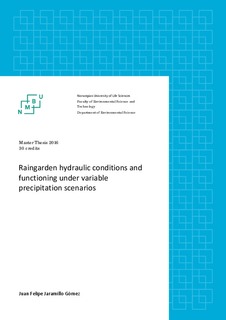| dc.contributor.advisor | French, Helen Kristine | |
| dc.contributor.author | Jaramillo Gómez, Juan Felipe | |
| dc.coverage.spatial | Aas, Norway | nb_NO |
| dc.date.accessioned | 2016-08-11T12:05:50Z | |
| dc.date.available | 2016-08-11T12:05:50Z | |
| dc.date.issued | 2016-08-11 | |
| dc.identifier.uri | http://hdl.handle.net/11250/2398819 | |
| dc.description.abstract | Stormwater can have several serious impacts on public health, infrastructure and landscape of cities. Two of the main negative impacts of urban stormwater are floods and water pollution. Raingardens are bio-retention systems where water and contaminants are retained due to infiltration into a filter media and temporary storage as surface water. The filter medium could be a natural or mixed soil (sandy + natural) that infiltrates and treat the stormwater. The raingarden vegetation will also help retain water and improve the water quality. Hence achieving a combination of the two important local stormwater management objectives peak flow reduction and water quality improvement. This study investigate a raingarden hydraulic conditions and functioning combined with modelling its functionality under variable precipitation scenarios.
The experimental raingarden is situated in the middle of the campus of the Norwegian University of Life Sciences, As, Norway. To quantify the hydrological performance and processes in the raingarden, recharge area was calculated, soil infiltration was measured with double ring infiltrometer before and after planting, and soil samples were collected to perform lab measurements of permeability, grain size distribution, organic carbon content, cation exchange capacity and water retention curve. Based on the physical description of the raingarden, the hydraulic processes were modelled with a numerical model for unsaturated and saturated flow.
The composition of the raingarden mixed soil samples produced a loamy sand texture with saturated hydraulic conductivity values according to the requirements from the different international and national recommendations. The CEC properties of the raingarden allows plant production and indicates the mixed soils have good clay content and OM presence, with high water holding capacity. The original raingarden design was compared with two modified versions under two different flow scenarios. Results suggest a good performance in terms of the retention time of potential pollutants, and in fluid mass reduction. | nb_NO |
| dc.language.iso | eng | nb_NO |
| dc.publisher | Norwegian University of Life Sciences, Ås | |
| dc.rights | Navngivelse 3.0 Norge | * |
| dc.rights.uri | http://creativecommons.org/licenses/by/3.0/no/ | * |
| dc.subject | Raingarden | nb_NO |
| dc.subject | hydraulic properties | nb_NO |
| dc.subject | modelling | nb_NO |
| dc.subject | storm water runoff | nb_NO |
| dc.title | Raingarden hydraulic conditions and functioning under variable precipitation scenarios | nb_NO |
| dc.type | Master thesis | nb_NO |
| dc.subject.nsi | VDP::Technology: 500::Environmental engineering: 610 | nb_NO |
| dc.subject.nsi | VDP::Mathematics and natural science: 400::Geosciences: 450::Hydrogeology: 467 | nb_NO |
| dc.source.pagenumber | 100 | nb_NO |
| dc.description.localcode | M-MINA | nb_NO |

